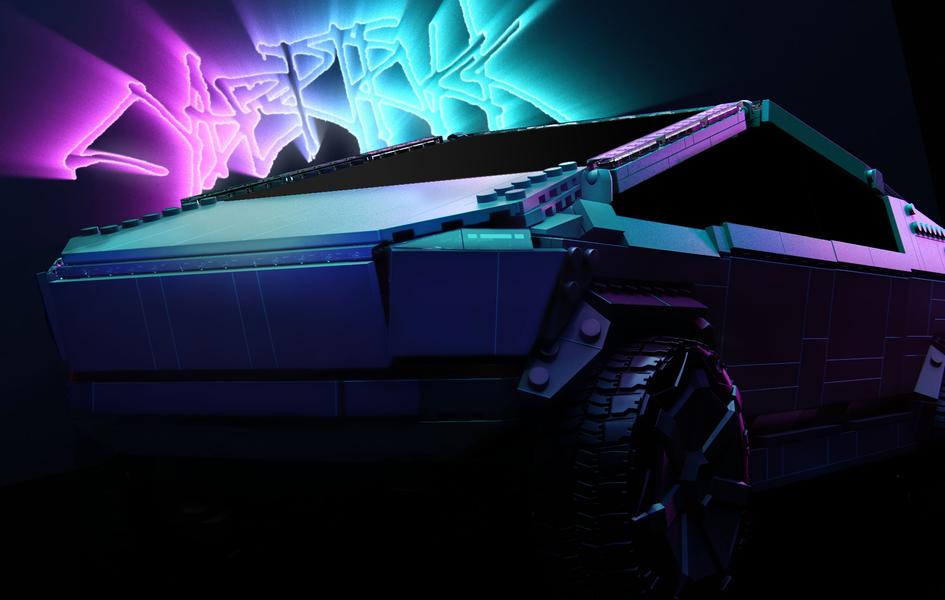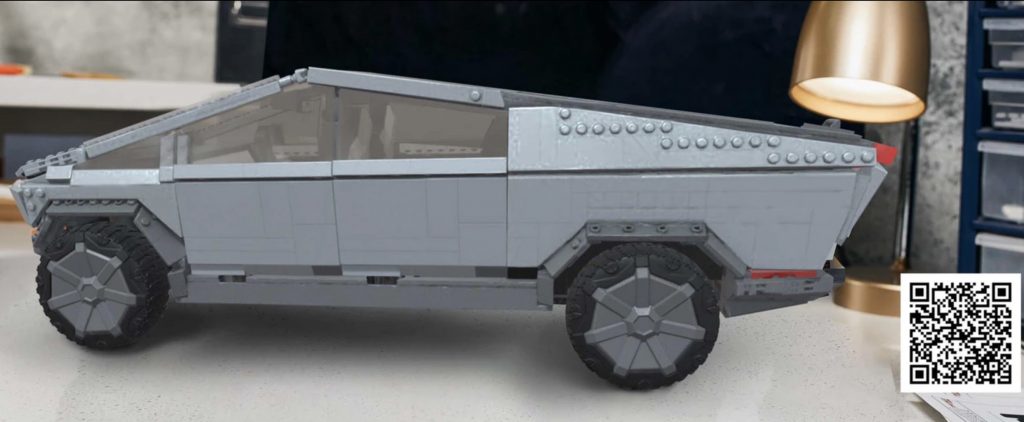

News
Mattel creates the perfect Tesla Cybertruck build LEGO never released
Mattel Creations announced MEGA would be dropping a Tesla Cybertruck build on October 15, 2021, at 9 a.m. Pacific Time. Similar to the Hot Wheels Cybertruck Mattel dropped previously, the MEGA version will feature some specific, unique details that can only be found on Tesla’s electric pickup truck.
Mattel’s MEGA brand produced building block toys for children. MEGA has teamed up with many well-known brands on some of its build sets, including Pokemon, Masters of the Universe, Borderlands, and Halo. According to Mattel’s announcement, MEGA loves the Cybertruck which may be why it decided to drop a MEGA x Cybertruck build.
“Inspired by the original designs from Tesla’s upcoming release, we created a MEGA X Cybertruck you can build brick by brick and customize to reveal different hidden features that can only be discovered while you build it,” wrote Mattel.
“The MEGA designers are committed—even obsessed—with making this model as true to form as possible. With over 3,000 pieces in this building set, you will be able to discover all the details like the sharp-angled exoskeleton, adjustable air suspension, armor glass windows, and even more Easter eggs while you put this brick model together. This buildable MEGA X Cybertruck is the pinnacle of our devotion and literally puts the future in your hands,” read the announcement.

Based on pictures of MEGA’s Cybertruck build, designers appear to be focusing on the Cybertruck displayed during the unveiling event. It will also feature the Armor Glass windows of Tesla’s futuristic pickup truck. The MEGA X Cybertruck build is priced at $250.00. Anyone interested in purchasing the set can explore the Cybertruck build with MEGA’s interactive and immersive AR experience through the QR code in the picture above.
More information may come out about the MEGA x Cybertruck build set in the future. Hopefully, the set’s production does not run into the same challenges as the Hot Wheels Cybertruck models. The Hot Wheels Cybertruck entered its own production hell, leading to delivery delays, similar to the Tesla’s Model 3 production hell in 2018.
Tesla Cybertruck fans would likely appreciate Mattel’s LEGO-esque version of the all-electric pickup truck. Tesla fans have previously petitioned LEGO to release a Cybertruck build as part of its “Ideas” program. Even after garnering enough votes to be reviewed by LEGO, however, the toy-maker decided to deny the proposed Cybertruck kit. Mattel’s more detailed Cybertruck kit could then be seen as validation of sorts, as it shows just how cool the all-electric pickup truck could be.
“Our team has thoroughly considered the possibility of releasing this project as a LEGO set according to the criteria of the LEGO Review. Unfortunately the LEGO Review Board has decided that we will not produce this project as a set,” LEGO noted.
At the 2021 Shareholders Meeting, Elon Musk estimated that Tesla Cybertruck production could start by 2023. He mentioned that Tesla is facing supply chain challenges that make production difficult. The pandemic has affected the global supply chain, affecting many different industries, including automakers and tech companies.
The Teslarati team would appreciate hearing from you. If you have any tips, reach out to me at maria@teslarati.com or via Twitter @Writer_01001101

Elon Musk
Elon Musk and Tesla AI Director share insights after empty driver seat Robotaxi rides
The executives’ unoccupied tests hint at the rapid progress of Tesla’s unsupervised Robotaxi efforts.

Tesla CEO Elon Musk and AI Director Ashok Elluswamy celebrated Christmas Eve by sharing personal experiences with Robotaxi vehicles that had no safety monitor or occupant in the driver’s seat. Musk described the system’s “perfect driving” around Austin, while Elluswamy posted video from the back seat, calling it “an amazing experience.”
The executives’ unoccupied tests hint at the rapid progress of Tesla’s unsupervised Robotaxi efforts.
Elon and Ashok’s firsthand Robotaxi insights
Prior to Musk and the Tesla AI Director’s posts, sightings of unmanned Teslas navigating public roads were widely shared on social media. One such vehicle was spotted in Austin, Texas, which Elon Musk acknowleged by stating that “Testing is underway with no occupants in the car.”
Based on his Christmas Eve post, Musk seemed to have tested an unmanned Tesla himself. “A Tesla with no safety monitor in the car and me sitting in the passenger seat took me all around Austin on Sunday with perfect driving,” Musk wrote in his post.
Elluswamy responded with a 2-minute video showing himself in the rear of an unmanned Tesla. The video featured the vehicle’s empty front seats, as well as its smooth handling through real-world traffic. He captioned his video with the words, “It’s an amazing experience!”
Towards Unsupervised operations
During an xAI Hackathon earlier this month, Elon Musk mentioned that Tesla owed be removing Safety Monitors from its Robotaxis in Austin in just three weeks. “Unsupervised is pretty much solved at this point. So there will be Tesla Robotaxis operating in Austin with no one in them. Not even anyone in the passenger seat in about three weeks,” he said. Musk echoed similar estimates at the 2025 Annual Shareholder Meeting and the Q3 2025 earnings call.
Considering the insights that were posted Musk and Elluswamy, it does appear that Tesla is working hard towards operating its Robotaxis with no safety monitors. This is quite impressive considering that the service was launched just earlier this year.
Elon Musk
Starlink passes 9 million active customers just weeks after hitting 8 million
The milestone highlights the accelerating growth of Starlink, which has now been adding over 20,000 new users per day.

SpaceX’s Starlink satellite internet service has continued its rapid global expansion, surpassing 9 million active customers just weeks after crossing the 8 million mark.
The milestone highlights the accelerating growth of Starlink, which has now been adding over 20,000 new users per day.
9 million customers
In a post on X, SpaceX stated that Starlink now serves over 9 million active users across 155 countries, territories, and markets. The company reached 8 million customers in early November, meaning it added roughly 1 million subscribers in under seven weeks, or about 21,275 new users on average per day.
“Starlink is connecting more than 9M active customers with high-speed internet across 155 countries, territories, and many other markets,” Starlink wrote in a post on its official X account. SpaceX President Gwynne Shotwell also celebrated the milestone on X. “A huge thank you to all of our customers and congrats to the Starlink team for such an incredible product,” she wrote.
That growth rate reflects both rising demand for broadband in underserved regions and Starlink’s expanding satellite constellation, which now includes more than 9,000 low-Earth-orbit satellites designed to deliver high-speed, low-latency internet worldwide.
Starlink’s momentum
Starlink’s momentum has been building up. SpaceX reported 4.6 million Starlink customers in December 2024, followed by 7 million by August 2025, and 8 million customers in November. Independent data also suggests Starlink usage is rising sharply, with Cloudflare reporting that global web traffic from Starlink users more than doubled in 2025, as noted in an Insider report.
Starlink’s momentum is increasingly tied to SpaceX’s broader financial outlook. Elon Musk has said the satellite network is “by far” the company’s largest revenue driver, and reports suggest SpaceX may be positioning itself for an initial public offering as soon as next year, with valuations estimated as high as $1.5 trillion. Musk has also suggested in the past that Starlink could have its own IPO in the future.
News
NVIDIA Director of Robotics: Tesla FSD v14 is the first AI to pass the “Physical Turing Test”
After testing FSD v14, Fan stated that his experience with FSD felt magical at first, but it soon started to feel like a routine.

NVIDIA Director of Robotics Jim Fan has praised Tesla’s Full Self-Driving (Supervised) v14 as the first AI to pass what he described as a “Physical Turing Test.”
After testing FSD v14, Fan stated that his experience with FSD felt magical at first, but it soon started to feel like a routine. And just like smartphones today, removing it now would “actively hurt.”
Jim Fan’s hands-on FSD v14 impressions
Fan, a leading researcher in embodied AI who is currently solving Physical AI at NVIDIA and spearheading the company’s Project GR00T initiative, noted that he actually was late to the Tesla game. He was, however, one of the first to try out FSD v14.
“I was very late to own a Tesla but among the earliest to try out FSD v14. It’s perhaps the first time I experience an AI that passes the Physical Turing Test: after a long day at work, you press a button, lay back, and couldn’t tell if a neural net or a human drove you home,” Fan wrote in a post on X.
Fan added: “Despite knowing exactly how robot learning works, I still find it magical watching the steering wheel turn by itself. First it feels surreal, next it becomes routine. Then, like the smartphone, taking it away actively hurts. This is how humanity gets rewired and glued to god-like technologies.”
The Physical Turing Test
The original Turing Test was conceived by Alan Turing in 1950, and it was aimed at determining if a machine could exhibit behavior that is equivalent to or indistinguishable from a human. By focusing on text-based conversations, the original Turing Test set a high bar for natural language processing and machine learning.
This test has been passed by today’s large language models. However, the capability to converse in a humanlike manner is a completely different challenge from performing real-world problem-solving or physical interactions. Thus, Fan introduced the Physical Turing Test, which challenges AI systems to demonstrate intelligence through physical actions.
Based on Fan’s comments, Tesla has demonstrated these intelligent physical actions with FSD v14. Elon Musk agreed with the NVIDIA executive, stating in a post on X that with FSD v14, “you can sense the sentience maturing.” Musk also praised Tesla AI, calling it the best “real-world AI” today.








